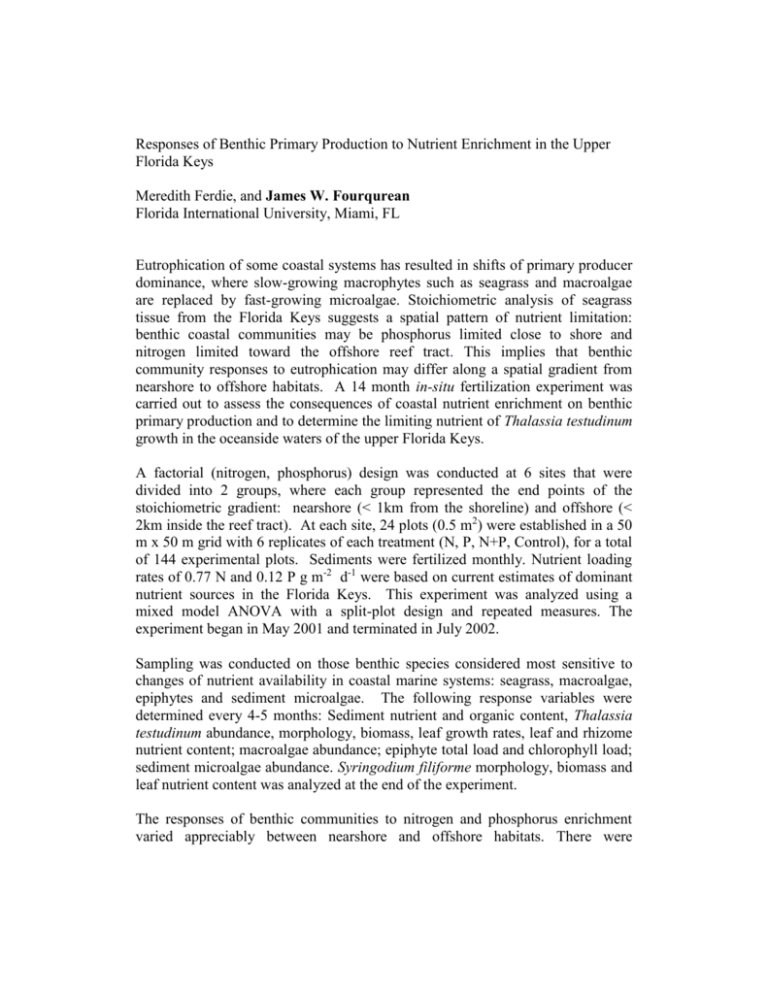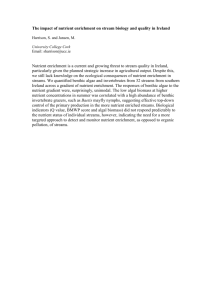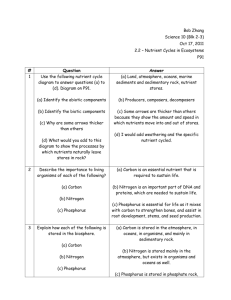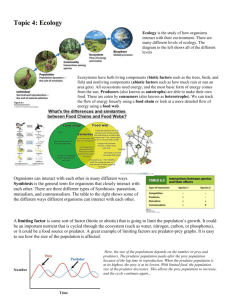Responses of Benthic Primary Production to Nutrient Enrichment in
advertisement

Responses of Benthic Primary Production to Nutrient Enrichment in the Upper Florida Keys Meredith Ferdie, and James W. Fourqurean Florida International University, Miami, FL Eutrophication of some coastal systems has resulted in shifts of primary producer dominance, where slow-growing macrophytes such as seagrass and macroalgae are replaced by fast-growing microalgae. Stoichiometric analysis of seagrass tissue from the Florida Keys suggests a spatial pattern of nutrient limitation: benthic coastal communities may be phosphorus limited close to shore and nitrogen limited toward the offshore reef tract. This implies that benthic community responses to eutrophication may differ along a spatial gradient from nearshore to offshore habitats. A 14 month in-situ fertilization experiment was carried out to assess the consequences of coastal nutrient enrichment on benthic primary production and to determine the limiting nutrient of Thalassia testudinum growth in the oceanside waters of the upper Florida Keys. A factorial (nitrogen, phosphorus) design was conducted at 6 sites that were divided into 2 groups, where each group represented the end points of the stoichiometric gradient: nearshore (< 1km from the shoreline) and offshore (< 2km inside the reef tract). At each site, 24 plots (0.5 m2) were established in a 50 m x 50 m grid with 6 replicates of each treatment (N, P, N+P, Control), for a total of 144 experimental plots. Sediments were fertilized monthly. Nutrient loading rates of 0.77 N and 0.12 P g m-2 d-1 were based on current estimates of dominant nutrient sources in the Florida Keys. This experiment was analyzed using a mixed model ANOVA with a split-plot design and repeated measures. The experiment began in May 2001 and terminated in July 2002. Sampling was conducted on those benthic species considered most sensitive to changes of nutrient availability in coastal marine systems: seagrass, macroalgae, epiphytes and sediment microalgae. The following response variables were determined every 4-5 months: Sediment nutrient and organic content, Thalassia testudinum abundance, morphology, biomass, leaf growth rates, leaf and rhizome nutrient content; macroalgae abundance; epiphyte total load and chlorophyll load; sediment microalgae abundance. Syringodium filiforme morphology, biomass and leaf nutrient content was analyzed at the end of the experiment. The responses of benthic communities to nitrogen and phosphorus enrichment varied appreciably between nearshore and offshore habitats. There were significant increases in T. testudinum length, abundance, biomass and growth rates in response to N addition, but not P addition, at offshore sites. This suggests that T. testudinum in offshore habitats in the upper Florida Keys are nitrogen limited. Significant increases in abundance and biomass of non-seagrass primary producers were found exclusively at nearshore sites, and most often encountered with +NP treatments. Macroalgae abundance (rhizophytic calcareous greens) and total epiphyte loads increased with +NP at nearshore, but not offshore sites. Increases in autotrophic epiphyte loads and sediment microalgae abundance were also found only at nearshore sites. -2 -1 Thalassia Areal Productivity (mg m d ) -2 -1 Thalassia Areal Productivity (mg m d ) The relative allocation of nitrogen and phosphorus to various seagrass system compartments (sediment, seagrass, algae, water column) was similar between nearshore and offshore sites. However, the net retention of added nutrients varied considerably based on nutrient 4 and location. Although total Inshore system nitrogen doubled with C +N nitrogen addition, less than 10 % +NP 3 +P of the added nitrogen was retained in that system. Phosphorus enrichment 2 dramatically increased total system phosphorus and up to 82 % was retained in the system. 1 The differences in nitrogen and phosphorus retention suggest Sep 01 Mar 02 July 02 that long-term phosphorus enrichment, unlike nitrogen enrichment, may be important as 4 a driver of long-term community Offshore changes because most of the C +N phosphorus is retained within +NP 3 +P the system, while much of the nitrogen is lost from the system. Nearshore systems may be 2 particularly vulnerable to phosphorus enrichment because the retention efficiency of 1 phosphorus at nearshore sites (82 %) was nearly twice that of Sep 01 Mar 02 July 02 offshore sites (49 %). Seagrass leaf nutrient content increased at all sites with the addition of nutrients, although the magnitude of these responses varied by time and location. Increases in T. testudinum leaf N content were apparent quickly (3 months of fertilization), whereas significant increases in P content were not observed at nearshore and offshore sites until 10 months and 14 months of fertilization, respectively. Relative changes in seagrass leaf and rhizome elemental content support strong nitrogen-limitation of offshore seagrass, and suggest that phosphorus might be more limiting at nearshore sites. Growth responses in this experiment did not consistently follow the nutrient content responses. Increases in T. testudinum leaf nutrient content, in the absence of a positive biomass or growth response, implies that nutrient availability in the study area was either insufficient to satisfy all plant metabolic demands for nitrogen and/or phosphorus, or that T. testudinum was efficient at luxury consumption. This study demonstrated that eutrophication of the coastal waters of the Florida Keys has the potential to affect benthic communities. Taxa-specific responses to nutrient enrichment varied by location: macro- and micro-algae responded at nearshore sites while seagrass species responded at offshore sites. The increase in macroalgae and microalgae abundance at nearshore sites followed the predicted sequence of community responses during eutrophication. This experiment also demonstrated that seagrass communities in oceanside waters of the Florida Keys are indeed nutrient limited, but the nature of that limitation is different for nearshore and offshore sites. Thalassia testudinum responded to N+P addition at nearshore sites, and N addition at offshore sites. The largest increase in seagrass biomass and growth was found at offshore sites, demonstrating that the offshore T. testudinum is strongly nitrogen limited. This investigation increases our ability to predict the effects of nutrient enrichment in seagrass communities and emphasizes the importance of nutrient supply in determining benthic community composition. The response of benthic communities in the oceanside waters of the upper Florida Keys to nitrogen and phosphorus enrichment varied significantly between the nearshore and offshore environment. Results may be used to model changes that anthropogenic eutrophication may cause in the subtropical coastal marine waters of the upper Florida Keys. Fourqurean, James W., Florida International University, 11200 SW 8 th St., Department of Biological Sciences, OE 167, Miami, FL 33199 Phone: 305-348-4084, Fax: 305-348-1986, Jim.Fourqurean@fiu.edu, Question 4








